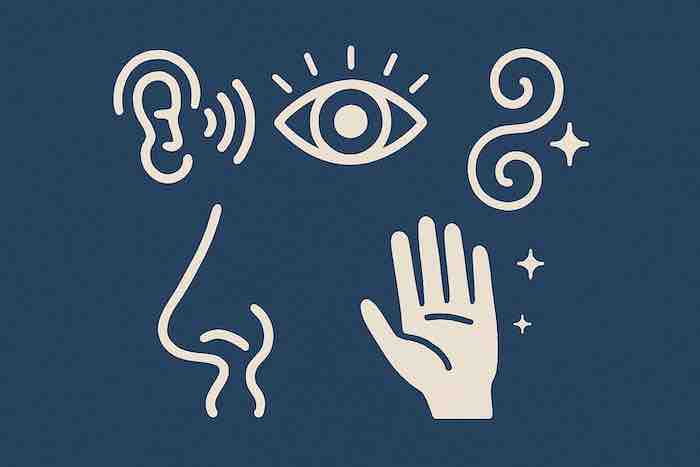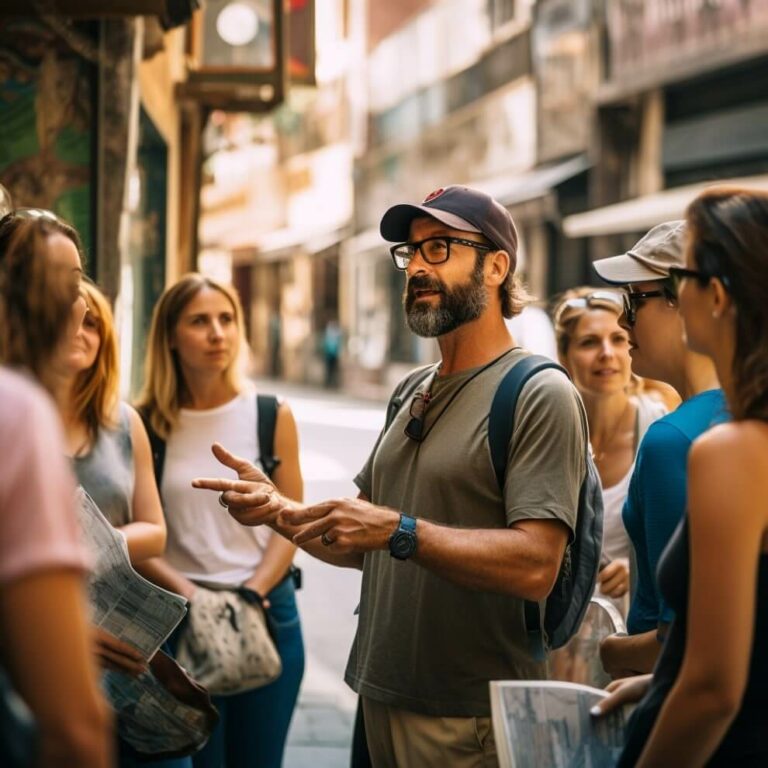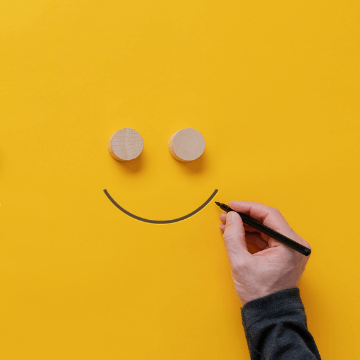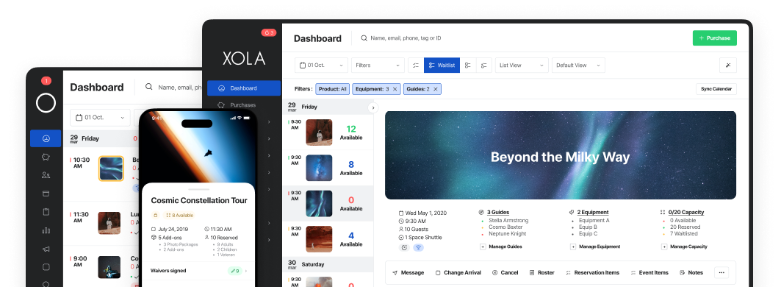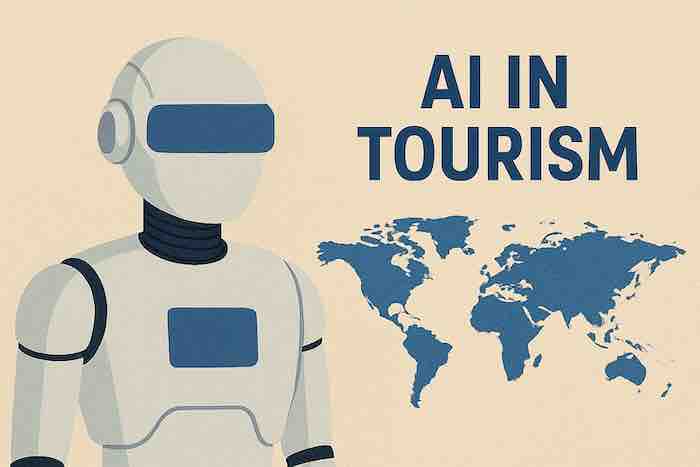
If you run a tour, attraction, or high-volume entertainment business, you’re not just in the business of guest experiences anymore, you’re in the data business.
And the leaders who figure that out fastest are the ones using AI tools to:
- Make better staffing and pricing decisions
- Personalize guest experiences at scale
- Free up their team from low-value, repetitive work
- Spot revenue opportunities before competitors do
This is about building smarter systems that drive revenue and guest satisfaction at the same time.
What is AI Marketing?
AI-powered chatbots may be the most obvious sign that artificial intelligence is making its mark on the tourism industry.
For instance, KLM Royal Dutch Airlines has a chatbot called BlueBot that assists passengers throughout their trip, providing flight information and handling customer service issues in real time. Meanwhile, Kayak’s integration with ChatGPT allows users to ask travel-related questions—like, “Where can I fly to for under $300 in April?”—and receive personalized recommendations based on their previous search criteria.
Still, there are many other ways this technology is being used.
Marketers are leveraging AI to analyze vast amounts of data to better understand customer behavior. Additionally, AI tools simplify repetitive tasks like email campaigns, customer service interactions, or content creation. By analyzing past behaviors and patterns, marketers can also more easily predict future trends.
Yet the most groundbreaking impact of AI marketing is the heightened level of personalization that brands can now offer. AI enables personalized recommendations using customer data to deliver tailored experiences across platforms.
Think personalized emails, product recommendations, or targeted advertisements that reach the right customers at the right time — precisely what your travel brand aims to do.
Why Is It Important for Attractions?
Salesforce research shows that 73% of customers expect companies to understand their unique needs and expectations, yet 56% say most companies treat them like numbers.
Attractions like theme parks, museums, and heritage sites often deal with large crowds and vast amounts of customer data. Enter AI tools—which can help simplify the collection and analysis of this data. Attractions can use this data to offer increasingly relevant and personalized guest experiences.
We commonly see this in the retail industry, where browsing history and past purchases are used to offer consumers relevant product recommendations. Amazon is a great example: The online retailer uses sophisticated machine-learning models to analyze user behavior and make increasingly accurate predictions about what products someone might want next. Personalized recommendations fuel over 35% of the online retailer’s total sales.
Similarly, AI can empower your attraction to make data-driven decisions that enhance customer satisfaction and boost booking revenue.
5 Key Trends in AI Marketing for Tourism
- Personalized travel experiences through AI – Tourism companies use AI-driven recommendation engines to tailor travel itineraries, activities, and accommodations based on traveler preferences. For example, platforms like Expedia and Kayak use machine learning algorithms to offer suggestions based on a user’s past searches and bookings — making it even easier for travelers to find exactly what they’re looking for.
- Chatbots for customer service – Chatbots have become ubiquitous in customer service. Platforms like Booking.com and Marriott use them to handle customer inquiries, bookings, and even cancellations 24/7. These bots use natural language processing (NLP) to provide immediate, tailored responses. This helps improve customer experience while freeing up your staff to focus on more pressing tasks.
- Dynamic pricing strategies – AI-driven dynamic pricing tools are becoming essential for hotels, airlines, and tour operators. Platforms like Airbnb and Expedia use AI algorithms to analyze demand, seasonality, competitor pricing, and events to adjust prices in real time. The right pricing strategy can increase your business’s return on sales by 2% to 7%.
- AI-powered travel assistants – About a third of U.S. travelers are open to using ChatGPT for trip planning. From using AI-powered bots to plan a family road trip to relying on an app’s recommendations for a full day in Kyoto, Japan, travelers use AI tools for all types of trips.
- AI for predictive analytics and forecasting – Just as airlines use AI to predict demand spikes and adjust capacity, tour operators and attractions now have tools to help them do the same. Predictive analytics allows companies like yours to set dynamic pricing, make personalized travel recommendations, and forecast demand.
AI Marketing Use Cases
Here are a handful of ideas for how you can leverage AI to drive more bookings, improve guest experience, and mine more customer insights from your existing data.
Personalizing Customer Interactions with AI
Forbes found that 81% of customers prefer companies that offer a personalized experience. Meanwhile, 70% say that a personalized experience in which the employee is aware of the customer’s past purchases, buying patterns, and support calls is important.
Disney’s MagicBand technology is one of the leading examples of AI-powered personalization in tourism. MagicBands are wearable “smart” wristbands that replace paper tickets, grant admission to rides and fast-track lines, and can act as payment in restaurants and shops.
The bands are also connected to beacons throughout Disney parks, relaying real-time information to the theme park. Disney then uses the data to personalize guest experiences in many creative ways: Guests’ names are shown on screens at the end of “It’s a Small World,” for example, and when their photos are taken on a ride, the images are automatically uploaded onto the app that the bands are integrated with.
Implementing AI Chatbots for Customer Service
Expedia’s chatbot technology has facilitated over 29 million virtual customer conversations, saving the company more than eight million hours in agent time.
Chatbots free up your staff’s time for mundane support tasks—like answering the most frequently asked questions—and cater to customers in different time zones at all times of the day.
Kayak’s integration with ChatGPT, for instance, allows travelers to ask questions about flights, hotels, or rental cars that would normally be directed at a travel agent. In return, they receive personalized recommendations based on their search criteria and KAYAK’s historical travel data.
Using AI As a Real-Time Customer Support Pilot
Booking.com uses AI chatbots to manage customer inquiries regarding bookings, cancellations, and accommodation details. Through Natural Language Processing and machine learning, these bots operate 24/7 and can easily handle complex queries.
As previously mentioned, AI-powered support systems can operate around the clock, providing travelers with instant assistance regardless of time zones or holidays. Yet, these systems are also highly scalable. They can handle thousands of interactions simultaneously without delays, making them especially useful during peak seasons or events.
Optimizing Marketing Campaigns with AI
AI algorithms analyze customer data from various sources—such as social media interactions, booking histories, and online behavior—to predict future trends and segment audiences effectively. From a marketers’ perspective, this is great news because it allows you to tailor campaigns to specific customer groups, ensuring that the right message reaches the right audience at the right time.
Tourism Australia uses AI to analyze the effectiveness of its global marketing campaigns. The AI system determines the best-performing content by monitoring engagement levels across various platforms. The tourism board then tailors future campaigns accordingly, achieving higher engagement and conversion rates.
Leveraging AI for Data-Driven Insights
AI systems can analyze customer data, such as booking patterns, demographic information, and past interactions, to create detailed customer profiles. These profiles enable brands to deliver hyper-personalized recommendations and services. For instance, AI can suggest tailor-made vacation packages based on a traveler’s previous preferences, such as highlighting boutique hotels for a guest who frequently books luxurious stays.
Skyscanner, a leading flight comparison platform, uses AI to track real-time competitor pricing. This information helps Skyscanner adjust its offerings, ensuring it remains competitive with its price-sensitive audience.
AI-Powered Ad Targeting and Retargeting
AI-powered ad targeting and retargeting have become crucial for maximizing ROI in the tourism and attraction sectors. AI-powered ad targeting collects vast amounts of user data and then uses that data to create highly detailed customer profiles and segments. By understanding these insights, AI can predict which types of content, products, or services are most likely to resonate with each user segment, allowing your attraction to display hyper-relevant ads to potential customers.
On the other hand, retargeting is a process where AI identifies users who have previously interacted with a brand but have yet to complete a desired action, such as purchasing or booking a tour. AI-powered retargeting systems then serve these users with personalized ads to re-engage them and guide them down the sales funnel.
An example can be seen in Marriott International’s use of AI-driven predictive analytics to analyze guests’ past booking behavior, spending patterns, and preferences. The hotel company uses this data to send its guests personalized offers, including local tour recommendations. Studies have shown that hotels using predictive analytics significantly boost repeat bookings, underscoring the power of data-driven personalization in the travel industry.
Automating Marketing Processes with AI
From campaign management to customer engagement, AI-powered automation tools streamline operations and help attractions deliver personalized experiences at scale.
AI can automate email campaigns by segmenting audiences based on behavior, preferences, and engagement history. For example, suppose a customer browses a safari tour on a travel website but doesn’t book. In that case, AI can trigger an automated follow-up email offering discounts or similar tour options. AI tools like Mailchimp and HubSpot use predictive analytics to determine the best time to send emails, increasing the likelihood of conversions.
You can also automate social media marketing with AI by scheduling posts and automatically analyzing their performance. Platforms like Hootsuite and Sprout Social automate the scheduling process, analyze audience behavior, and recommend the best times to post content to maximize reach and engagement. This automation saves time for tour operators and travel brands while ensuring consistency across social channels.
Content Creation and Curation with AI
Content marketing costs 62% less than traditional marketing — and generates about three times as many leads.
Marketing directors can leverage AI-powered tools like Jasper and Copy.ai to create blog posts, social media captions, and ad copy. These tools allow marketers to input specific information, such as tone, topic, and audience, that helps the AI tool create content tailored to a brand’s voice.
As helpful as these tools can be, it’s important to remember that Google recognizes when your content is generated by AI. And there’s a good chance your customers might notice, too. We like to think of AI-generated content as the skeleton of a piece of content, where, once created, marketers can add the “meat” of the subject.
Curating User-Generated Content with AI
With the rise of smartphones and high-quality cameras, you bet your guests are capturing their favorite moments during their visit. With the volume of UGC surging comes the need for effective content curation methods.
AI is reshaping this traditionally tedious process with algorithms that analyze customers’ behavior and preferences to recommend content that aligns with their interests. AI can also automate video editing, sifting through large volumes of footage and identifying key moments to focus on. Your attraction can also use it to automatically filter out inappropriate or harmful content, keeping your UGC ecosystem safe and respectful.
Let’s say a Hawaii sailing tour wants to track hashtags like #MauiSailing or #HawaiiSailTour. You could automate the process using an AI tool to collect photos and guest testimonials using that hashtag on Instagram. This approach ensures a continuous stream of fresh and authentic content that can be used to promote your tours and attractions.
Creating Visual Content with AI
A process that would’ve taken a professional graphic designer hours a few years ago can now be done by virtually anyone in just a few minutes. This is not-so-good news for designers, but it’s a pretty good deal for marketing directors.
One of the best AI tools for creating visual content is Canva. With the integration of AI, Canva now has a feature called Magic Design that can generate images and videos from a single text description. If you have a blog on your website, you could turn your posts into engaging graphics and captions shared on social media. Now, just think of all those possibilities.
Using AI for Search Engine Optimization
Nearly 70% of all tourism bookings were made online in 2023 — making your website’s search engine visibility paramount to your attraction’s success. With AI, marketers can now automate much of their search engine optimization (SEO) strategy. Tools like SEMrush and Ahrefs can help identify high-performing keywords, analyze competitors’ strategies, and suggest relevant topics to feature in your content. These SEO platforms can also analyze user experience factors that impact your Google rankings, such as page loading speed and mobile responsiveness.
AI Predictive Analytics for Tourism
Predictive analytics is the process of extracting valuable insights from data to predict future outcomes. In the context of tourism, this technology can help marketers forecast guest demand, nail their pricing strategy, and mitigate risks.
AI tools can do the heavy lifting for you, like gathering customer data from relevant sources like booking logs, customer satisfaction surveys, and social media interactions. Once the data is collected, AI-powered tools will clean it up, transform it into a usable format, and apply statistical techniques to extract meaningful insights. And this can all happen within a matter of minutes.
Airbnb, for example, adjusts its pricing based on current market conditions, historical booking patterns, and competitor pricing. This pricing strategy allows hosts to capitalize on high-demand periods while keeping their listings attractive to guests. In fact, hosts that use Airbnb’s dynamic pricing tools might see up to a 40% increase in their earnings compared to those who set a price and leave it.
AI in Influencer Marketing
AI is proving to be an asset in the influencer market, although not in the way you might imagine. There’s always the fear that AI-powered chatbots and other tools will “replace” human talent — in this case, the actual influencers.
However, AI should be viewed as an asset rather than a threat to all marketing channels. AI tools help marketers efficiently analyze audience behavior and interests and further identify the most suitable influencers for campaigns. Agencies can even forecast the success of influencer partnerships. Plus, AI allows real-time tracking of influencer marketing campaigns, allowing marketers to make quick adjustments that enhance the campaign’s performance.
***
From dynamic pricing and chatbots to smarter campaign targeting and UGC curation, there are practical ways to start small and scale up.
Whether you’re running a single attraction or managing multiple locations, the right AI tools can help you work more efficiently, personalize at scale, and ultimately drive more bookings.
The key? Start with use cases that support your existing strategy not distract from it.
